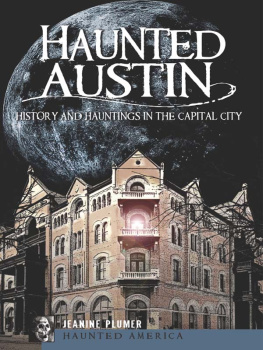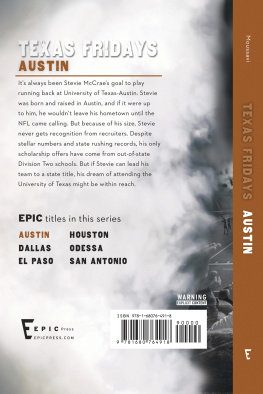


Published by Haunted America
A Division of The History Press
Charleston, SC 29403
www.historypress.net
Copyright 2010 by Jeanine Marie Plumer
All rights reserved
First published 2010
e-book edition 2012
ISBN 978.1.61423.373.2
Library of Congress Cataloging-in-Publication Data
Zeller-Plumer, Jeanine Marie.
Haunted Austin : history and haunting in the capital city / Jeanine Marie Zeller-Plumer.
p. cm.
Includes bibliographical references.
print edition ISBN 978-1-60949-040-9
1. Haunted places--Texas--Austin. 2. Ghosts--Texas--Austin. I. Title.
BF1472.U6Z44 2010
133.10976431--dc22
2010028133
Notice: The information in this book is true and complete to the best of our knowledge. It is offered without guarantee on the part of the author or The History Press. The author and The History Press disclaim all liability in connection with the use of this book.
All rights reserved. No part of this book may be reproduced or transmitted in any form whatsoever without prior written permission from the publisher except in the case of brief quotations embodied in critical articles and reviews.
CONTENTS
INTRODUCTION
Initially when I decided to start a walking tour company in Austin, my intention was to give tours about Austins unique history. While researching the old buildings downtown, the building occupants would mention with surprising frequency unexplainable events taking place that they attributed to a ghost. I would nod my head and pretend to listen, but really, I had never thought about ghosts in my life. Still, every now and then, on a tour I would mention that the building dwellers believed they had a ghost. When I mentioned that, the people in the tour group invariably lit up with interest. It became obvious: they wanted to hear ghost stories! It was then I decided to collect Austins ghost stories and create a ghost tour.
Of course, the first question to ask is who is haunting the building? It came to my attention that pretty much everybody believed their ghosts came into existence through some sort of drama. Each suicide or murder seemed to be over lost love. Every building was, at one point, a brothel or bordello, a speakeasy or gambling hall. Austins colorful famed gunfighter Ben Thompson was haunting every bar in the city. What ended up floating around with the ghosts were lots of urban legends, no real facts.
If I was going to tell Austins ghost stories, I was going to tell the real story. After all, we dont really know what is happening, but perhaps by telling the truth I would stay on the good side of the spirits.
What I discovered, of course, changed my life. Whatever you want to call these energiesghosts, spirits or soulsthey seem to be remnants of people who have lived, died and continue to reside. Why they choose not to leave, or whether theyre unable to, we dont know.
What you believe is your choice, but I can tell you without a doubt that there is something happening around us everywherebarely discernible, but very much there. After interviewing hundreds of people, it is clear what ghosts can do is astonishing. They can turn lights on and off along with televisions, cell phones, fire alarms and water faucets. They can open and close doors, windows and shades. They can move objects of all sizes, make phone calls, move furniture, knock on doors, ring doorbells and even talk to you. These occurrences are just some of the phenomena taking place in Austins buildings populated by the living and other-worldly beings. Point to ponder: a majority of people who experience what they believe to be a ghost do not feel fear.
When researching who these people might have been in life, I soon discovered that the residual energies that remained were not famous Austinitesthe infamous or those who were bigger than life in any way. The spirits that remain are regular people, like you and me. It is the woman who was widowed at a young age and opened a millinery shop on Sixth Street to support herself and her children; every morning, for much of her life, she sent her kids to school and went downstairs to open her business. Some part of her spirit is still doing that. It is the man who began working as a porter at the Driskill Hotel at age sixteen, the fourth generation in his family to do so, tending to guests into old age and beyond. It is the woman who entered the Confederate Womens Home when she was sixty-five years old and died there at the age of ninety. Every day for twenty-five years she walked the hallwaysand still does today.
My concluding belief is most ghosts remain because of life. The life they lived makes a stronger imprint than the process of their death.
CHAPTER 1
FLOOD VERSUS FAMILY
From the onset, the swollen motionless clouds that had settled over Austin were ominous. Massive storms had been moving through the central Texas region since Friday, April 6, 1900. In some areas, as much as seventeen inches of rain had fallen in only two days. Water poured from creeks and tributaries into the Lower Colorado, causing its waters to rage as it swelled the shore limits of Austins popular retreat Lake McDonald and sent a steady current over the wall of the Great Granite Dam.
The dam was a source of great pride for the city, gracing the cover of Scientific American magazine. In 1890, bonds were sold to cities in the east and $ 1 million was raised for the construction of a dam and $600,000 for a power plant. The dam was completed in 1893, and the waters it held back formed Lake McDonald. But despite its praise as an engineering marvel, not everyone agreed. In 1896, the mayor received a letter from Mr. Frizell, the chief construction engineer who was forced to resign during the construction of the dam, warning that there was a problem with the construction on the east side of the dam. In 1897, a fisherman noticed a six-foot-long hole beneath the dam. In 1899, a leak was discovered on the east side of the dam; it was patched with clay. Then, in early April 1900, the rain began.
The torrential downpour began in earnest late Friday afternoon, April 6, and continued. All night long the rain fell in solid sheets, reported the Daily Tribune. City residents knew to stay away from low water crossings and infrequently traveled dirt roads. Once the rain commenced mobility in and around the city was quickly limited to foot traffic or horseback. Scheduled meetings for groups such as the Cigar Makers Union, the Austin Garten Verwin, Pashahona Tribe 19 and the ancient Order of Hibernians were postponed.
Finally, on Saturday morning, April 7, the rain stopped and, with the dawn, only a few clouds and light drizzle remained. By midmorning, the sun had begun to shine, and some Austinites ventured out to work or play. But many more chose to make the trip along Dam Avenue, two miles west of downtown.
Word had spread rapidly through the city that the raging water around the dam was a sight to behold. The water had risen eleven feet above the dams summit and was cascading down in a wild torrent. Anxious to see the impressive sight, no one questioned the stability of the 60-foot high, 1,150-foot-long and 60-foot thick concrete and granite structure.
At 11:15 a.m., a shock rumbled like a smothered explosion, echoing for miles throughout the Hill Country as the dam split down the middle and the east side crumbled under the waters pressure, washing away. Below the dam, a fifty-foot wall of water descended as the thirty-mile-long and one-mile-wide Lake McDonald emptied into the already swollen Colorado.
Next page










